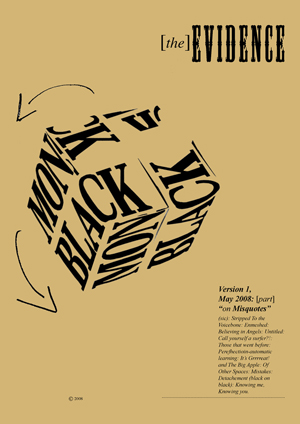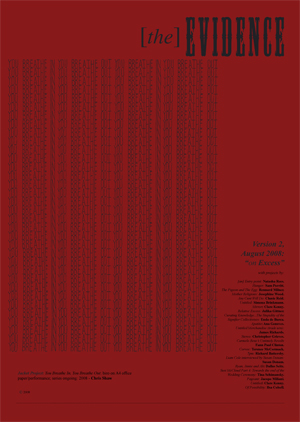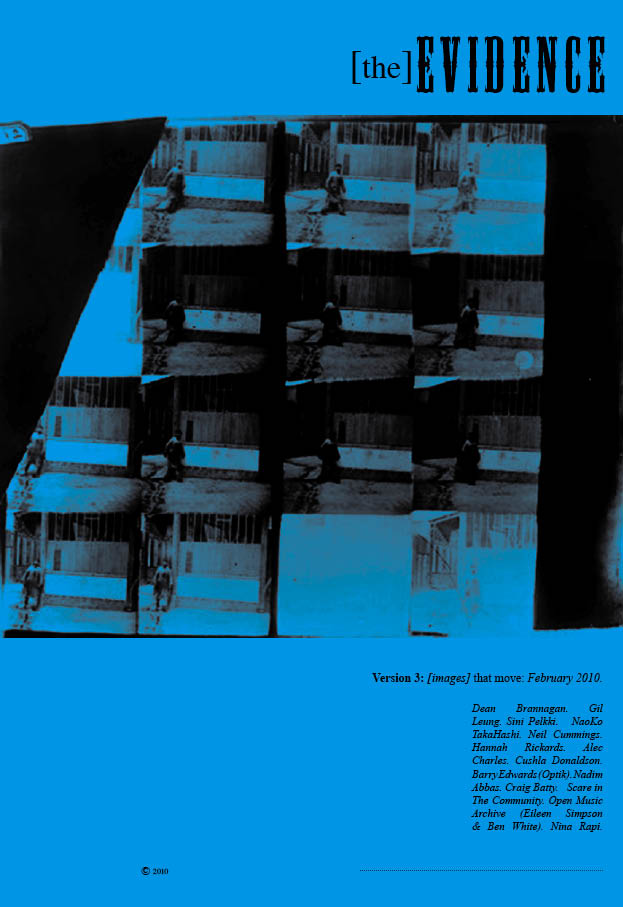ethos ...current ...back ...events ...projects ...subscribe ...contact ...links .
.......................................................................................................................................................................................
[previous] versions of [the] Evidence.
.......................................................................................................................................................................................
[Towards] an Introduction (excerpt) - Version 1 - on Misquotes: Natasha Rees.
This inaugural issue fixates on “misquotes”. Potentially funny and fatal, the misquote can be a misunderstanding based on insularity, bad hearing, or a misreading. Misquoting can be ignorance, a rhetorical offensive or a breach of an established ideology. Similarly, they can be (un)intentional slippages from one possibility (or reality) into another, having the capacity to redirect a meaning toward an alternative meaning. The misquote is owned by the ‘speaker’ of that misquote, who’s intention may be distinct, haphazardous or vague. Misquotations may be new posits of information cited by the perpetrator through playful (or petulant) means - that are creative improvements on the original. They can also disrupt the basic nature of something, altering its features to procure a new ‘species’ - cynically or earnestly...Effectively, the misquote can be an embarrassing mis-take or a radical (re)suggestion that transforms the original statement into something innovative ….or arbitrary.
Version 1: has sold out - but a FREE pdf copy is available here.
 |
Version 1: On Misquotes, Contents: |
|---|
.......................................................................................................................................................................................
[an] Entry point: (Introduction On Excess, Version 2): Natasha Rees.
Also identified as a glut; a surfeit; an overloading; surplus; an overkill or ‘ecstatic’ effusion, Excess implies the violation of a boundary or an infringement on that which is moderate or low-key. Whether literal or symbolic, Excess is mass that’s an overproduction of more than is essential, obligatory, or desired. Excess can also signify a stark competitiveness between itself and inadequacy – or an accepted, conservative, measure of something. In sound, this could be punk; noise; thrash metal; drone music... John Cage’s music could be seen as excessive because of its abundant silence. Excess can be empty pages or pages crammed
with
full-stops…
The first time I saw Der siebente Kontinent (“The Seventh Continent”, Michael Haneke’s first feature of 1989) it struck as one of the most systematic films I’d seen. By scrutinising perfunctory routine, it focuses on the lives of a ‘first world’ family who reject the values attached to their existence, through suicide. What Haneke deploys in this film I think, is a structure that highlights the subtle infestation of how being “forced to serve everyday things” can smother a fulfilling inner life and sense of purpose. Of how a closely-knit, professional family unit creepingly comprehends its lack of true drive through obdurate daily rituals – radio alarm at 6am; preparing and eating breakfast; dressing for work and school; grocery shopping and so on, to realise the traps and futility of its materialistic subsistence. In Haneke’s words; “they don’t really live, they do things”. The parents also understand that there is nothing left in their lives to salvage, too far down the line are they to recouperate any purpose of engagement.
Instead of coercing this (true) story towards a feeling of emancipation, Haneke maintains the film in a firm stasis. It’s clear that the family’s decision to disengage is not a happy one and this keeps Der siebente Kontinent away from sentimental, fake optimism. What is optimistic about the film, is that it’s made precisely in this way. The ‘shock’ remains in the ease with which modern living has a capacity to corrode fundamental human-ness. Haneke has remarked, that “by explaining the effects...we can tell stories with a clear conscience, rather than pretending to know the causes”, and when the family destroy their possessions and themselves, it is with the same rhythm and anxious calm with which they built their lives.
The idea of boundary here is an uneasy one, as the antagonism between conformism and the will to find meaning erupts violently within the family’s final gesture.
......................................................................................................................................................................................
Version 2: has sold out - but a FREE pdf copy is available here.
|
Version 2: On Excess, Contents: Sam Porritt, courtesy Brown Gallery For more information or links to artists websites, |
|---|
......................................................................................................................................................................................
Version 3 - images that move - buy.
|
Version 3: [images] that move Jacket project: Dean Brannagan Editorial: [fly] with a camcorder, between the familiar and the not so unfamiliar..: Natasha Rees The politics of a persistence of image: Gil Leung On DVD: Play, 2010. |
|---|
© Copyright material 2007-2017.
ARCHIVE


